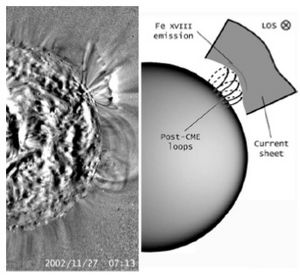RHESSI Deep Integrations
From RHESSI Wiki
| RHESSI Deep Integrations | |
|---|---|
| Number: | 111 |
| 1st Author: | Pascal Saint-Hilaire |
| 2nd Author: | |
| Published: | 28 September 2009 |
| Next Nugget: | 112 |
| Previous Nugget: | RHESSI in Cycle 24 |
| List all | |
Contents |
Introduction
Every individual X-ray photon detected by RHESSI gets its own unique telemetry allocation. This makes great flexibility possible, in principle, since the "observer" can pick and choose how to integrate these photon counts into images and spectra. Earlier Nuggets([1] and [2]) explained this, but we describe here one of the first applications of this capability for really deep integrations of faint sources: the detection of a very long-lived coronal X-ray sources associated with a CME. Because RHESSI forms images, long integrations of the data permit greater sensitivity, essential for studying the middle corona (say, above 0.1 RSun in height) with its low plasma density and hence low [emissivity].
Current Sheets associated with CMEs
A coronal mass ejection ([CME]) has the clear appearance of an catastrophic expansion of the coronal magnetic field; indeed the structure becomes so large that it passes the [critical point] and enters the [solar wind] itself. This requires a great deal of energy, but essentially every X-class solar flare is accompanied by a CME. In the aftermath of a CME, the solar wind finds itself with too much magnetic flux, and to return to its steady state it needs to create shorter magnetic connections from the newly "opened" field. This requires [magnetic reconnection] and the likely formation of a [current sheet] where the reconnection takes place. This would be a linear structure extending essentially radially outward from the flare. All of this is well worked out conceptually, and supported by much observational work; indeed the current sheets themselves may be detectable via UV line emissions in high-temperature lines.
The instrument that has produced the best evidence for CME-related current sheets is [UVCS] on the [SOHO] spacecraft - a venerable space observatory launched in 1995 into the L1 [Lagrangian point] of the Sun-Earth system. Its observations of an event of 2002 November 26 (see reference [1]) inspired the RHESSI analysis described here and in reference [2]. During this event the UV spectra showed emission from a line formed above 8 MK (Fe XVIII at 974A) for more than two days, and much other evidence suggested that this emission could in fact be associated with the magnetic reconnection required for the restoration of a "normal" solar wind. Such high temperatures put this event squarely into RHESSI's comfort zone for observation of thermal X-radiation (ie, that from a hot [Maxwellian] plasma). Moreover the physics of magnetic reconnection might involve the acceleration of a non-thermal electron population that RHESSI could detect at higher energies as well.

Figure 1 shows the layout of the event as a difference image of the W hemisphere of the Sun, as seen in the 304 A ([He II]) passband of [EIT]. This difference clearly reveals the huge arcade of loops that follows the flare and CME, with a characteristic white/black pattern signifying the occurrence of loops at higher and higher altitudes.
Above these loops we see the characteristic near-radial rays that presumably extend into the solar wind following the CME itself.
The cartoon at the right of Fig. 1 shows a quadrangular shaded area that represents the current sheet, conceptually a planar structure separating the opposite magnetic polarities. This is where the magnetic reconnection needs to happen, and the association of the hot FeXVIII line with this process (as discussed in reference [1]) follows the logic that the heating results from this reconnection.
RHESSI Observations
Conclusions
References
[1] Current Sheet Evolution in the Aftermath of a CME Event
[2] X-ray Emission from the Base of a Current Sheet in the Wake of a Coronal Mass Ejection
| RHESSI Nugget Date | 28 September 2009 + |
| RHESSI Nugget First Author | Pascal Saint-Hilaire + |
| RHESSI Nugget Index | 111 + |
